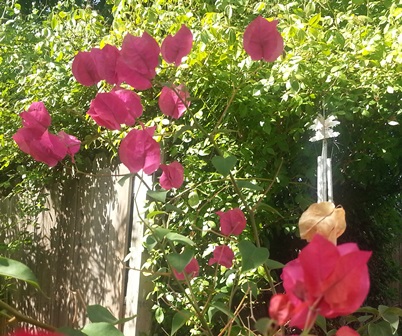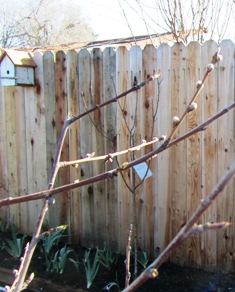Bougainvillea Vines Are Valued for Their Vibrant Color
If you’re looking for something that gives dense cover with green leaves and has prolific flower production, think about planting some bougainvillea vines. After my husband recently picked up four bougainvilleas in gallon-pots from our local nursery where the plants were on sale, we planted them around the front porch.
When you buy them in pots during spring and summer, you can pick bract color. The nearly inconspicuous blooms are surrounded by large, vibrantly colored bracts. Color choice ranges from red, orange, pink, fuchsia, deep purple, and white.
You’ll need to protect these evergreen shrubby vines where frost is expected. They’ll benefit from being moved to a warm wall. In fact, bougainvillea will thrive in the warmest parts of the garden. That said, they may even need a little shade protection in extremely hot areas.
Since the roots aren’t interwoven tightly in a root ball, you’ll want to plant them with care or slice the sides of your plastic gallon pot a half-dozen times, fold back, and plant pot and all in the planting hole.
Spring and summer are the best times to fertilize. Prune to renew the plant in the spring after the danger of frost is over. Many bougainvillea plants are tall growing varieties but you can also find some considered low- to medium-growing shrubs. These vines are show-stoppers with curb appeal and an even better value when you get them discounted at your local plant nursery.
Plum and Prune Trees Reward with Foliage, Blooms, and Fruit
We are growing several plum and prune trees here on the farmette, but because some were given to us as shoots from other people’s trees we don’t know the exact identity of some of our trees. However, the fruit from them is delicious.
A plum we are growing along the back fence of our property produces tons of bloom and lots of small-to-medium fruit with deep red coloring. The tree is self-fertile. Fruit aside, the tree has lovely dark reddish-purple leaves, spring to summer. We like the foliage so much that when it sprouted (plums love to sprout new shoots), we culled a couple of sprouts for new trees. Now we have three of those plums on our property and believe the cultivar to be a European Damson.
Another plum given to us is a yellow variety. The first year we lived here, that plum tree gave us a large-size crock bowl full of sweet, yellow, good-quality fruit. We believe it is self-fertile (although we keep honeybees and our neighbor’s have plum trees that quite possibly pollinate ours).
We are aware of a couple of yellow plums. One is a Japanese cultivar–Shiro–that produces a golden yellow plum with yellow flesh. Another is a European variety–Yellow Egg–that is self-fertile and produces large, oval, yellow-fleshed fruit. I do not know if the tree we are growing belongs to either of these types.
Last spring, we planted a self-fertile French prune–Agen. The fruit is small, red to purplish black with a sweet taste. It’s a late producer but is the standard drying prune for California. It can also be canned.
Plum and prune trees aren’t too fussy about soil, but they do respond to a feeding now and then. Japanese plums can easily take one to three pounds of nitrogen annually, while European plums will do well with one to two pounds of nitrogen.
Pruning is required. Japanese plums benefit from severe pruning at all stages (prune to a vase shape). European plums should also be trained to the vase shape and benefit from an annual pruning when the trees are mature to thin out shoots.
Thinning fruits (one fruit for every four inches) as soon as they form will yield stronger trees and larger fruit. As for pest, use an organic dormant spray for pests that winter over. Otherwise, plum and prune trees are joy to grow in the garden for their foliage, blooms, shade, and fruit.
Growing Palate-Pleasing Peaches
In the orchard area of the Henny Penny Farmette, we’ve planted several fruiting peach trees. Today, during this first full week in February, the Desert Gold peach trees (Prunus persica) broke into bloom.
These trees are more tolerant of heat than some of the varieties, but if planted in the desert Southwest or even in the hot interior valleys of California, the peach trees will perform better if given a little afternoon shade.
There are basically four types of peach trees: fruiting, flowering, combination fruiting and flowering, and dwarf. All peaches require heat during the hot weather months of their growing cycle and won’t properly set many blooms or be well pollinated during springs that are cold and wet. These trees also need some chilling during the winter months when they drop their leaves and go dormant.
We’ve discovered that our peach trees benefit from regular feedings (I’ve used fish emulsion tea, manure tea, and even chicken manure worked into the soil around the base of the tree) two or three times a year. For mature trees, plan on cutting away 2/3 of the previous year’s growth or cut each branch back about 1/3 it’s total length.
The Internet has some great videos that demonstrate how to properly prune your peach trees.
If you’ve prune your peach tree properly, you’ll have lovely, large fruits. Another technique to increase fruit size is to thin the number of fruits on the tree. Taking away some of the smaller fruits and reducing the size of the crop means that the remaining fruit can enlarge before ripening.
Peach leaf curl, peach leaf borer, and scale insects are pesky problems for peach growers and gardeners. Treatment requires spraying with Bordeaux mixture or lime sulfur twice a year. Nurseries suggests you spray your peach trees in November and again just before the buds swell.
Now, our trees are ready to flower, be pollinated by the honeybees, and produce some luscious peaches by the end of May. I’ll use the ripe peaches to make some palate-pleasing jams.
 Facebook
Facebook Goodreads
Goodreads LinkedIn
LinkedIn Meera Lester
Meera Lester Twitter
Twitter








